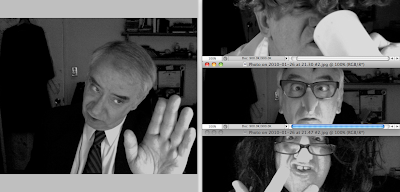
One of my guilty pleasures is this stuffed goat sculpture by Robert Rauschenberg. If you try to argue me out of this I'll have no choice but to turn and run. That's 'cause I don't have the slightest idea why I like it, I just do.

I confess that I like some of his environmental art, too. My favorite is the large, enclosed field of bubbling mud, above. I don't blame you if you're skeptical, but trust me, I've seen it and it looks a lot better than it reads in print. In real life it oozes, plops, bubbles and slaps, and you can't take your eyes off it.
Architects were dying to figure out a way to incorporate it into buildings, but nobody could think of how. It's not structural. You can't walk on it. Eveybody agrees that it's somehow architectural, but how? Nobody knows...but it certainly is inspiring. It's all about bringing nature into buildings. Rauschenberg made us want to see the wonders of the natural world inside our homes and workplaces, not just in zoos or museums.

Here's (above) some workers in an ugly modern room. But wait, what's that above their heads? You can't see it clearly here, but the designer put LCD screens above the workers' heads, and on the screens are videos of moving clouds, including thunder clouds. Imagine if the whole ceiling were like that. Imagine your overhead light being alternately dappled or partly cloudy. Imagine the mood of such an office at night with video moonlight illuminating the rims of clouds, and moody low-level lighting taking up the slack. The spirit of Rauschenberg strikes again!

Everybody wants to try out flight simulators. Soon LCD displays (above) will be so cheap that, sitting at home or at work, we'll see what an airline pilot sees outside his window, or what a ship captain sees when he's caught in a hurricane, or what a submarine commander sees when he looks out into the Marianas Trench. Maybe we can put little cameras on ants and see what they're seeing when they work all day inside their hill. Imagine that as a background while you work at a desk filling out insurance forms. Rauschenberg would have loved it.

Or maybe he wouldn't. I picture him saying, "No, no, no! What I meant was that we should bring real nature indoors!" That seems to imply indoor trees or birds, or aquariums.


Imagine a quarter mile-long, giant aquarium with mysterious caves and corals, as well as fish. Imagine if various businesses along its length shared walls with it. That may not be practical now, but you know it will be somewhere down the line.

Or maybe it's cheaper to have people look at other people rather than fish. If more buildings were shaped like inverted pyramids, we could have floors like this (above).

It would be best if the floor was clear, structural glass (above), with a minimum of metal bars. Here we're bringing nature indoors, but it's not trees or plants...it's the awesome fact of gargantuan real world volumes and spaces.

Rauschenberg did a lot to popularize the idea that architecture (above) should be fun. It doesn't have to cost a lot of money.
Thanks to the site "Crooked Brain" for most of these pictures. That's a terrific design site, frequently updated. Check it out!














































